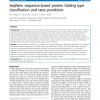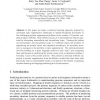119 search results - page 9 / 24 » Weave amino acid sequences for protein secondary structure p... |
BMCBI
2010
13 years 7 months ago
2010
Background: Protein folding rate is an important property of a protein. Predicting protein folding rate is useful for understanding protein folding process and guiding protein des...
ISMIS
2005
Springer
14 years 1 months ago
2005
Springer
In this paper, we adapt a statistical learning approach, inspired by automated topic segmentation techniques in speech-recognized documents to the challenging protein segmentation ...
EUROGP
2004
Springer
14 years 26 days ago
2004
Springer
Predicting the three-dimensional structure of proteins is a hard problem, so many have opted instead to predict the secondary structural state (usually helix, strand or coil) of e...
BMCBI
2006
13 years 7 months ago
2006
Background: Predicting residues' contacts using primary amino acid sequence alone is an important task that can guide 3D structure modeling and can verify the quality of the ...
BMCBI
2006
13 years 7 months ago
2006
Background: More and more disordered regions have been discovered in protein sequences, and many of them are found to be functionally significant. Previous studies reveal that dis...


